#takosader's ramblings number nine... number nine...
Explore tagged Tumblr posts
Text
So, about that "Marauder" build I was doing...
Breaking news: it is no longer a Marauder build!
For context of the people who randomly stumble across this post without all the lore and shit from my megapost back in August, first of all, hi, welcome to the blog, second of all, this was originally intended as a "recreation" or full copy of a pretty obscure mid-'60s Fender guitar that never saw full, mainstream production - the Fender Marauder.
For further context, the Fender Marauder was a guitar that got a mashup of all of Fender's offsets, plus the Stratocaster, getting the Strat's pickup layout, a pickup selection method similar to the Jag, the Jazzmaster's lead/rhythm circuit, plus a vibrato like the Mustang, and the headstock of the Starcaster, which didn't exist at that point, so it's technically that the Starcaster had the Marauder's headstock, rather than the other way around...
Where was I? Ah, yes, not doing the Fender Marauder. Yeah, no, it's not happening anymore. Instead, the build has, for lack of a better term, "pivoted", thanks to an idea my aunt gave me: doing something original.
Now, in Current Year (2024 is soon to end, and oh dear god it's almost a year since I had the idea for the Tele-Shaped Rickenbacker), originality in the guitar-building world is... not exactly a thing? There's that many Telecaster and Stratocaster copies, combined with the fact that there's only so many ways you can shape a slab of wood into a pleasant experience to play.
My solution? The academic method! And by that, I mean "instead of ripping off one guitar and calling it a day, I'm ripping off multiple guitars," or at least taking from multiple sources, as an academic should.
If you want to see more of this madness, keep reading under the cut.
You still here? Awesome. So, now that you've chosen to read on, let's go through the spec sheet that I made for this exact purpose! Surely, it can't be that incomprehensible, ri-
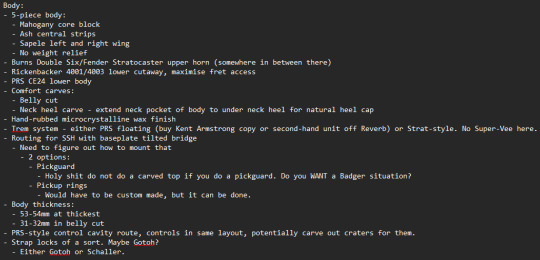

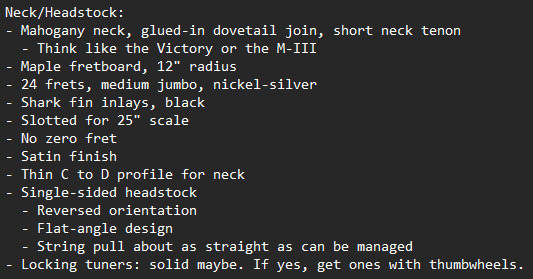
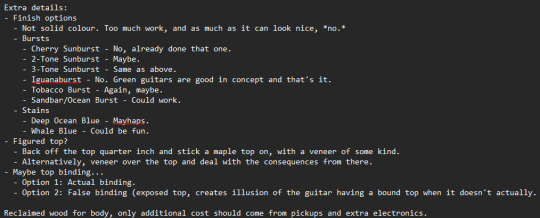
...oh.
Yeah, I went really in-depth. I even mentioned the fucking fretboard radius, that is how in-depth I went. Now, does this in-depth nature help? Oh yeah, certainly. Is it comprehensible? Nope. Not in the slightest. Not unless you browse Wikipedia for fun or watch way too much of Trogly's stuff.
So, a small glossary of terms, before we get into this shit properly:
Comfort carves: bits of wood removed from the body of the guitar to allow for better playing experience, originating with the Stratocaster.
Trem system: also known as a whammy bar or vibrato, this is how you get those reductions in pitch.
Coil split and coil tap: either factoring out one coil's output (split) or removing the effect of some of the windings of the coil (tap).
That's nowhere near all I've got to explain, but if any of you wanted, I'll put out a "translated" spec sheet that attempts to properly explain the shit. Anyway, where was I? Ah yes!
The build no longer being a Marauder has freed me up to do whatever I want now, which leads me to the body design (further screenshots will come from the translated spec sheet mentioned above):

So, let's discuss why those three specifically. But first, were they the original ideas? Not in the slightest! Originally, this was going to be FAR more Gibson-inspired than this, taking from the Scarred Reaper (a Jagstang style merging of the Les Paul and SG created by the aforementioned Trogly, I would recommend you watch his stuff if it wasn't so Guitar Nerd) and the SGV/ZV (that Zakk Wylde signature thing the Gibson custom shop cooked up), with maybe a single-sided headstock.
That idea's gone, DOA when further thought was brought in. The new idea, as specified in the image, is a hodge-podge of 2 guitars and a bass, all 3 of which I've played previously in some manner or form. The upper horn of a Burns Double Six, which (for those less educated in guitars, or can't just visualise a guitar from memory as soon as it's brought up in a conversation) looks like this:
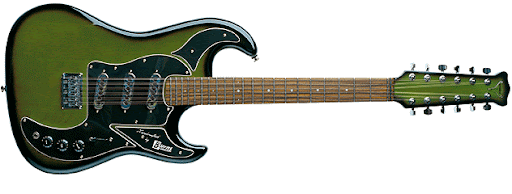
Yes, the guitar body looks like that. Plays beautifully, or at least the one I played does.
So that's the source of the upper horn, even if it'd be less exaggerated than that. What about the other two? Let's start with the lower cutaway, inspired by the Rickenbacker 4001 (or 4003) bass.

Note how the fret access is incredibly good? Yeah, that's not just a thing on the bass. Rickenbacker also make/made a guitar version of this, the 480 (plus a short-lived version known as the 481 with slanted frets - not fanned, slanted), with at least 21 frets of perfectly fine access to frets, and 24 frets total on the neck.
Finally, the PRS CE24, which is being used for the lower body of the guitar:

I could go on for several paragraphs about how and why I'm going with the lower bout of a CE24 for this, or even that I'm basiclally making this a more PRS-style Strat than the John Mayer Silver Sky. But, I won't. Quite simply, I have neither the time nor the energy. Instead, what I'll do is summarise, because I can't put a second read-more link in here.
So, why is it a PRS-style Strat? Well, many reasons. I'm thinking of putting in a PRS floating trem system, doing a 10-degree headstock angle (enough to have the tension, but not enough to risk headstock breaks - looking at you, Gibson, with your 17-degree headstocks!), and, most importantly, I'm going for a 25" scale length, which effectively gives me the very basics of a PRS guitar, minus the construction and the pickups.
But continuing from there, the only thing preventing this from being a "normal" PRS build or similarly designed guitar is the pickups I'm using. They're not any of the usual fare that PRS use, not by any stretch of the imagination. What I'm planning on using is, as laid out in the spec sheet, a Fender-style Wide Range Humbucker, a reverse-wound, reverse-polarity Tri-Sonic imitator (because I don't want to try and source Burns or Adeson pickups for this, so Kent Armstrong it is), and a Tonerider Hot Classics Broadcaster bridge pickup (it's the bridge pickup specifically because a Telecaster's bridge pickup is tilted with a black bobbin). Now, dear reader, can you guess what positions I'm going to put them in?
If you guessed that I'm going to be sane and normal by putting the humbucker in the bridge, you're entirely incorrect, unfortunately! Instead, I'm going for an at least sane positioning for the Broadcaster pickup, putting that next to the trem system, or at least as close as can be within reason, that RWRP Kent Armstrong Tri-Sonic in the middle position, and the humbucker in the neck position.
The result of that, in concept, should be a fuller sound in the neck, and depending on how I wire the pickups (which will most likely be in series) a really bitey sound in the bridge, the kind that gives some levels of distortion a run for its money. A comparatively "thin" sound is to be expected, as this project is to have 24 frets, and thus a tighter pickup spacing.
The idea is similar to this guitar made for Alex Lifeson by Paul Reed Smith (yes, that's what PRS stands for), which uses an EMG in the neck, and a Signature Guitars single coil in the bridge, with Signature Guitars being a short-lived brand that Lifeson worked with in the mid-to-late '80s until the company's dissolution in 1990.
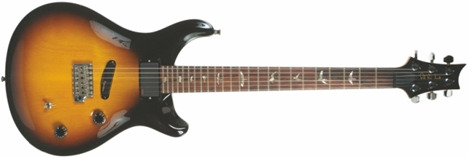
That's partially what's inspiring me on this specific pickup configuration, as I've heard the tones that this specific guitar's made, going back to at least 1991, for the solo on Dreamline. Considering the guitar's serial dates it to 1990, so it's likely he got it from PRS for the explicit purpose of recording the Roll The Bones album.
But that's not important, nor is it even the point, because damnit, I love rambling about tangential shit! Anyway, to get back to the point of this rambling, this is a PRS-style Strat in the least Strat-like manner. None of the parts I took from are a Strat, or really have any relation to it outside of the Double Six. The CE24 is inspired the double-cuts that Gibson made, and the 4001 was made back when originality was actually a thing in guitar design.
But the result of all that designing, combined with a little bit of image compositing, was this:
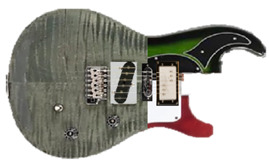
Now, I'm aware that this design, for lack of a better term, looks like shit. It's way too stretched out, and nowhere near like realistic. In my full defense, this was made in Paint at close to midnight, so I doubt I was thinking at full brain power. I'll probably de-stretch it at some point, if I can be arsed to do so.
The neck, by comparison, doesn't look nearly as bad, but considering how hard it is to fuck up the look of a neck, it's not that big a deal. The idea of a neck is to give an anchor point for the non-ball end of the string that allows for a tension adjustment point, with the fretboard acting as the point where frets change the note/pitch the guitar plays.
As God Pythagoras Intended.
Side note, fuck that guy! He broke music 2000 years ago, and we still haven't recovered!
Back to the matter at hand, though, my compositing process for the neck was based on inlay style, number of frets, and headstock shape. Now, I mentioned above that I was doing a 2-octave neck, 24 frets total. The "neck" (by which I mean the fretboard) was taken from a Rickenbacker 360, and the headstock shape was taken from a Gibson Firebird, the last remaining relic of this thing's Gbison influences, resulting in this composite:

Please note that the transparency for all this was done in Word, which is the best I can use to get specific bits and pieces of guitars to mash up and weld together like fucking Victor Frankenstein.
The full thing, combining both neck and body composites, came out of this process looking like this...
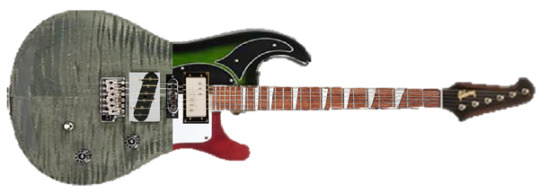
...as you can see, very squashed, very stretched, which was not the intention, I assure you! So, as a help to my brain, and possibly to the very few people who stumble across this who know good proportioning, I squashed the width down a bit further, albeit at the cost of making the neck feel too short for the body:

I could throw a squashed down version of the body back into Paint, add the standard-sized neck, and operate from there on the image front, but there's a small issue of CBA to contend with. In short, I can't be bothered to do it.
Now, you might note that the headstock lacks tuner tips. Why? Because the Firebird had planetary tuners, what some would term "banjo tuners". The basic idea is that, to facilitate string pull, they made a new headstock design (because before this there were 3 Gibson headstock styles - open book, which was the standard one, triangle, for the Flying V and related models, and hockey stick, which only got used on the Explorer until Aldo Nova came along in 1982). This new design utilises the planetary tuners for... some reason, Idk, I can't find it. Point is, at first, this is what I was going to go with, Firebird headstock shape and all.
However, upon further rational thought, I'm just going to go with a Hamer-style headstock, specifically one like the Hamer USA Centaura, which looks like this:
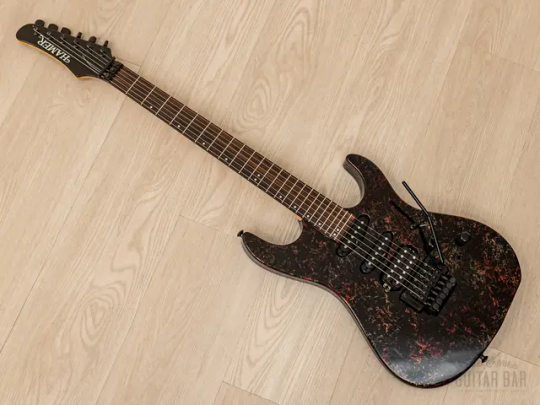
I was kinda debating on putting a Floyd Rose or similar on this, being influenced by this thing, but they're not exactly cheap to install, replace or repair, so that's why the PRS trem. The one thing I'm still debating on from this is the "sweet switch", which was designed for Carlos Santana by PRS, purely because he was known for using a long cable prior to going wireless. But that's not the point.
What is the point? Fuck if I know. I've been writing this on and off over the past 2 or 3 days, I just set out to make an in-depth Tumblr post about my guitar build, and here I am talking about a Hamer and Carlos Santana. To try and steer myself back to the point, let's talk the unique bits, stuff I've only seen done... 2 or 3 times, total. In this case, I'm talking about unique pickup selection methods.
There's a couple I have in mind for this build: a rotary switch, and individual slider switches. Now, why are these unique? Because both are rare to see on production-level guitars. The former comes from PRS guitars from the '90s, which worked really well, except people couldn't figure out what pickup they were on, while the latter I've only seen in 2 different styles on a total of 3 guitar models.
Style 1 is what I'm thinking of doing: Jag style, where there's a control plate to select what pickup you're using, and you can select and swap on the fly, which is similar to the Red Special, which has 3 pickup switches and 3 phase switches - the top row is pickups, and the bottom row is the phasing. Brilliant bit of kit for a guitar built 60 years ago.
Now, the other style of switching is a bit more convoluted than that, because it's Mustang switching, which is 3-position sliders mounted horizontally above each pickup. Position closest to the bridge is off, central is on, and position closest to the neck is out of phase. Sounds like the Red Special's method but condensed into 3 switches, right?
Well, the fact of the matter is that Brian's design and build was done between 1963 and 1964, and the Mustang didn't enter production until the latter year, so it's likely but not certain to be a case of convergent design/evolution.
Each idea has its merits. While, yes, a rotary switch would be less clunky, not to mention easier to install, you then have to manually wire each and every pickup combination you want. Now, that's fine and dandy with 2 humbuckers, you can do full neck, outer coils, both pickups, inner coils, full bridge, and in fact, that's how PRS did it. The issue is doing 3 pickups, one being a humbucker, and the other two being single coils, because then you need at least 7 positions, by my measure:
Neck
Neck + Middle
Neck + Bridge
Middle
Middle + Bridge
Bridge
All 3 together.
Now, I could be missing the forest for the trees, or at least the wood for the figuring, but I'd rather avoid having to wire up 7 different positions, especially because I'm not doing any fancy pots here. By comparison, individual switching seems more appealing, as there I can just have 3 switches for neck, middle and bridge, and be done with the whole matter.
Moving on from that, we have the aesthetics of it. I don't know what finish I'm gonna go for, considering I've debated at least 6 different finishes in my head for this build since I started it. I've debated on 2-Tone Sunburst, 3-Tone Sunburst, Tobacco Burst, Sandbar Burst, deep ocean blue, whale blue, grey black, all sorts. In theory, any of these 6 I listed could be the one I go with, which is pretty obvious.
Then again, I could go with some mad bastard finish like Faded Whale Blue Smokeburst (diluted Whale Blue stain, add on top a black ring on the front, dark sides, kinda tear drop figure on the back like an old '70s silverburst, the works) and deal with the convolution of doing that on a flame top.
Maybe I'll end up doing that. Who knows.
Oh, I almost forgot! I even gave it a name: the Crusader, acknowledging that a) it's my design, and b) it was based on the Marauder. It's going to be a long road to its completion, possibly a full year (remember, this is with hand tools, no large scale machinery) instead of the 6 months it took to build the Cherry XII. Most of it's going to be either mahogany or sapele, with the odd bit of maple or ash in there, but by the end of it, I'll have something unique to call my own. You couldn't get me to give it up if you tried.
Things I didn't go into detail about:
Binding stuff
Neck heel carve
Locking tuners
Inlay style
Possibly other shit I'm forgetting
Hope you enjoyed reading my ramblings this time!
#guitar building#lutherie#takosader's ramblings number nine... number nine...#that's a beatles joke btw#prs guitars#burns guitars#rickenbacker#not really a fender anymore#gibson guitars#if y'all want the translated spec sheet#don't be afraid to ask#otherwise it's languishing on my hard drive#and no one wants that#also did i mention this is mostly reclaimed wood#yeah the body's gonna be mostly made of door#it's solid fucking mahogany!!!#the kinda stuff you wish for when building this kinda stuff!#anyway there's swearing in here...#somewhere in here; i'm not scrolling through 3 days' worth of ramble just to tag hyper-accurately
2 notes
·
View notes